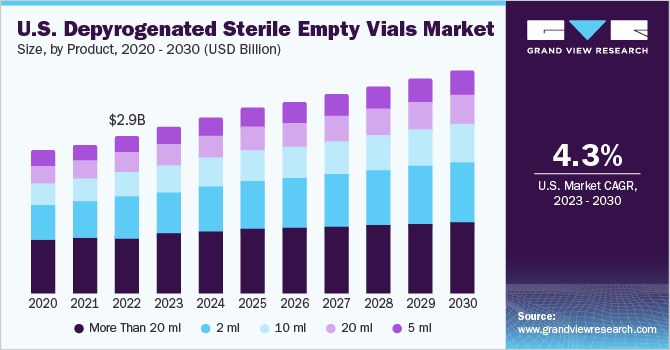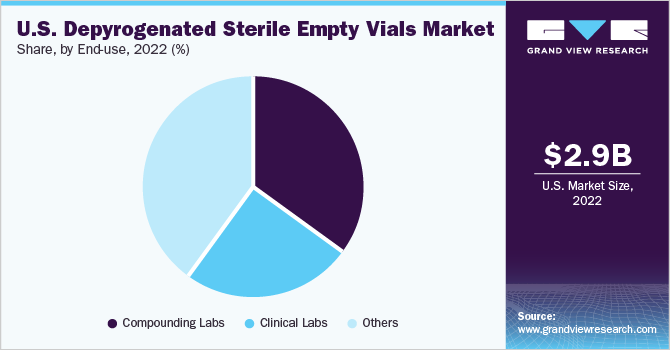- Home
- »
- Medical Devices
- »
-
U.S. Depyrogenated Sterile Empty Vials Market Report, 2030GVR Report cover
![U.S. Depyrogenated Sterile Empty Vials Market Size, Share & Trends Report]()
U.S. Depyrogenated Sterile Empty Vials Market Size, Share & Trends Analysis Report By Product (2 ml, 5 ml, 10 ml, 20 ml), By End-use (Clinical Labs, Compounding Labs), And Segment Forecasts, 2023 - 2030
- Report ID: GVR-2-68038-620-2
- Number of Report Pages: 71
- Format: PDF, Horizon Databook
- Historical Range: 2018 - 2021
- Forecast Period: 2023 - 2030
- Industry: Healthcare
Report Overview
The U.S. depyrogenated sterile empty vials market size was estimated at USD 2.98 billion in 2022 and is expected to expand at a compound annual growth rate (CAGR) of 4.25% from 2023 to 2030. Technological advancements in pharmaceutical packaging, rapid expansion in the pharmaceutical sector, and the rising number of clinical laboratories are some of the primary growth stimulants for the market. Increasing government support for the development of innovative packaging of pharmaceutical products is likely to help the market gain significant momentum in the coming years. For instance, in 2017, the U.S. President promoted a pharmaceutical packaging initiative, which was led by specialty glass marker Corning, Inc. and two pharmaceutical companies namely, Merck, Co., and Pfizer, Inc. Collaboration is made to enhance the storage and delivery of pharmaceutical formulations.

The market is anticipated to expand due to the rising prevalence of infectious disorders worldwide. Injectable drugs used in the treatment of infectious disorders are kept in depyrogenated, sterile vials. Recent technological advancements in the vial manufacturing processes are resulting in the development of innovative vials that enhance the storage and dispensing of drug formulations. This, in turn, is fueling the demand for depyrogenated sterile empty vials. In November 2022, Stevanato Group and Gerresheimer AG introduced EZ-fill Smart, a new Ready-To-Fill vial platform. It is designed to reduce the total cost of ownership & lead times for customers and improve drug packaging quality.
The flourishing biotechnological market in the U.S. is also one of the factors boosting the demand for depyrogenated sterile empty vials. A rising number of research institutes, labs, and biopharmaceutical companies is working in favor of the growth. Surging demand for compounding medications coupled with the trend of personalized medications is further bolstering the product demand.
According to the International Academy of Compounding Pharmacists, about 7,500 compounding pharmacies in the U.S. specialize in advanced compounding services, and 3,000 of these pharmacies are involved in compounding sterile products. There are stringent regulatory guidelines in the country for the manufacturing and packaging of parenteral products, which include requirements of sterilization and no presence of endotoxin, RNase & DNase. This results in an increased demand for depyrogenated sterile vials.
Product Insights
Based on product, the market is segmented into 2 ml, 5 ml, 10 ml, 20 ml, and more than 20 ml. In 2022, the more than 20 ml vials segment dominated with a revenue share of 37.0%. These vials are mainly used in the packaging of injectables. Rising incidence of infectious & non-infectious diseases in the U.S. and increasing R&D in the area of biopharmaceuticals are contributing to the growth of the segment. According to the Pharmaceutical Research and Manufacturers of America, in 2022, biopharmaceutical companies invested around USD 122.0 billion in research & development activities in the U.S.
Mounting disease burden and a growing number of clinical studies are resulting in increased demand for injectables, which in turn is fueling the demand for depyrogenated sterile empty vials of more than 20 ml. Moreover, recent technological advancements in parenteral packaging are playing a vital role in the development of the segment. For instance, Coring Internal Thread Cryogenic Vials manufactured by Corning, Inc. offers special barrier property that enhances the shelf life of the drug. It is used for parenteral applications.
The 2 ml segment is expected to grow at the fastest CAGR of 5.5% over the forecast period. The growing number of clinical & diagnostics labs and research institutes is projected to drive the demand for these vials for sample collection, storage, and transportation. According to several sources, the U.S. has the highest number of innovative research institutes in the world. Apart from this, rising government funding for the promotion of pharmaceutical, medical, and biotechnological research is further anticipated to bolster the growth of the segment during the forecast period.
End-use Insights
Based on end-use, the U.S. depyrogenated sterile empty vials market is segmented into clinical labs, compounding pharmacies, and others. In 2022, the others segment dominated the market with a share of 40.0%, owing to factors such as rapid growth in the pharmaceutical manufacturing sector, rising number of research institutes, and increasing government funding for research activities. Factors such as growing innovation in pharmaceutical packaging processes, the rapid development of new biologics, and a rising number of medical and biotech research projects are contributing to the market growth.

The clinical labs segment is expected to grow at the fastest CAGR of 4.8% during the forecast period. Growing incidence of communicable as well as non-communicable diseases and a widening base of testing labs are stimulating the growth of the segment. According to the estimates of the Laboratory of Florida, LLC, about 200,000 clinical labs are present in the U.S. that provide testing services to people.
Key Companies & Market Share Insights
The market is highly fragmented with high entry barriers. Companies are investing in R&D to gain competitive advantages. Moreover, growing collaborations between industry players is also one of the strategies being undertaken by the companies. Some prominent players in the U.S. depyrogenated sterile empty vials market include:
-
Thermo Fisher Scientific, Inc.
-
VWR International, LLC
-
Stevenato Group
-
SiO2 Medical Products, Inc.
-
DWK Life Sciences
-
Merck KGaA
-
Corning, Inc.
-
SCHOTT Corporation
U.S. Depyrogenated Sterile Empty Vials Market Report Scope
Report Attribute
Details
Revenue forecast in 2030
USD 4.20 billion
Growth rate
CAGR of 4.25% from 2023 to 2030
Base year for estimation
2022
Historical data
2018 - 2021
Forecast period
2023 - 2030
Report updated
September 2023
Quantitative units
Revenue in USD million/billion and CAGR from 2023 to 2030
Report coverage
Revenue forecast, company share, competitive landscape, growth factors & trends
Segments covered
product, end-use
Country scope
U.S.
Key companies profiled
Thermo Fisher Scientific, Inc.; VWR International, LLC; Stevenato Group; SiO2 Medical Products, Inc.; DWK Life Sciences; Merck KGaA; Corning, Inc.; SCHOTT Corporation
Customization scope
Free report customization (equivalent up to 8 analyst’s working days) with purchase. Addition or alteration to country, regional, and segment scope
Pricing and purchase options
Avail customized purchase options to meet your exact research needs. Explore purchase options
U.S. Depyrogenated Sterile Empty Vials Market Report Segmentation
This report forecasts revenue growth at the country level and analyzes the latest industry trends in each of the sub-segments from 2018 to 2030. For this study, Grand View Research has segmented the U.S. depyrogenated sterile empty vials market report based on product and end-use:
-
Product Outlook (Revenue, USD Million, 2018 - 2030)
-
2 ml
-
5 ml
-
10 ml
-
20 ml
-
More than 20 ml
-
-
End-use Outlook (Revenue, USD Million, 2018 - 2030)
-
Clinical Labs
-
Compounding Labs
-
Others
-
Frequently Asked Questions About This Report
b. The U.S. Depyrogenated Sterile Empty Vials market size was estimated at USD 2.98 billion in 2022 and is expected to reach USD 3.1 billion in 2023.
b. The U.S. Depyrogenated Sterile Empty Vials market is expected to grow at a compound annual growth rate of 4.25% from 2023 to 2030 to reach USD 4.20 billion by 2030.
b. The other end-use segment, consisting of pharmaceutical manufacturers and academic & research institutes, dominated the U.S. Depyrogenated Sterile Empty Vials market with a share of 40.2% in 2022. This is attributable to rising rapid growth in the pharmaceutical manufacturing sector, rising number of research institutes, and increasing government funding for research activities.
b. Some key players operating in the U.S. Depyrogenated Sterile Empty Vials market include Thermo Fisher Scientific, Inc.; Gerresheimer AG; SCHOTT AG; DWK Life Sciences; and Stevanato Group.
b. Key factors that are driving the U.S. Depyrogenated Sterile Empty Vials market growth include technological advancements in pharmaceutical packaging, rapid expansion in the pharmaceutical sector, Increasing government support for the development of innovative packaging of pharmaceutical products, and rising number of clinical laboratories.
Share this report with your colleague or friend.
![gvr icn]()
NEED A CUSTOM REPORT?
We can customize every report - free of charge - including purchasing stand-alone sections or country-level reports, as well as offer affordable discounts for start-ups & universities. Contact us now
![Certified Icon]()
We are GDPR and CCPA compliant! Your transaction & personal information is safe and secure. For more details, please read our privacy policy.
We are committed towards customer satisfaction, and quality service.
"The quality of research they have done for us has been excellent."





